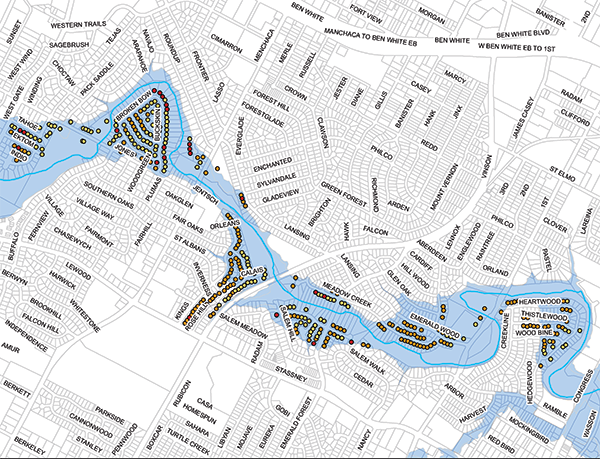Optional buyouts are one of three alternatives under consideration for reducing the risk of flooding along the middle portion of Williamson Creek. This alternative would include the buyout of up to 317 houses, 73 multi-family structures and six commercial buildings at risk of flooding. With full participation, all the structures at risk of flooding in the new 100-year storm would be removed.
Buyouts could be scaled back based on different criteria as shown by dots on the map below. Scenarios could include those at risk of flooding in the smaller, 25-year storm (yellow), those only at risk of flooding in the larger 100-year storm (orange) or those with repetitive flood damage (red).
Summary Evaluation
With full participation, buyouts provide the best flood protection and are potentially the fastest to implement. But, they break up neighborhoods, and it can be difficult to leave behind a beloved home. Buyouts would also remove housing stock when Austin needs more housing.
- Flood protection: Up to 396 structures
- Cost: $20 million to more than $250 million, depending on the number of structures.
- Timeline: 2 to 5 years, once funding is secure
If buyouts are selected, more information will be provided at that time. However, since buyouts would have a significant impact on individual households, we are providing an overview of the process to help answer any immediate questions.
Buyout Offers
Offers would be for the fair market value of the house as determined by an independent appraisal. The fair market value is what a willing buyer would pay a willing seller for the property. It is not the appraisal value as determined by the Travis County Appraisal District (TCAD).
Buyout Process
In the past, for large buyouts, we have staggered the buyouts, contacting a handful of homeowners each month to begin the process.
- Initial meetings: We would conduct an initial one-on-one meeting with each property owner to explain the details.
- Appraisal: An independent appraiser would visit the property to determine its fair market value. A second appraiser reviews the appraisal for accuracy.
- Offer: The City would make an offer to the property owner for the fair market value. If an owner disagrees with the fair market value, the owner could counter offer by providing more information.
- Closing: The City would work with the property owner to set a closing date that is convenient for them. The City requires that the property be vacant on the day of the closing.
- Post-Closing: The City would test, abate and properly dispose of any asbestos or lead containing materials in the house. Afterwards, a contractor would demolish the house, remove the foundation, and remove any sidewalks or driveways out to the limits of the street or right-of-way. Utility connections would be terminated and capped, and the lots would be regraded and revegetated. The property would be maintained as open space in perpetuity.
Detailed Evaluation
Several scenarios were evaluated. Within each scenario, we only considered habitable structures such as a houses, apartments or businesses, not sheds. We looked at the elevation of the first floor and compared that to the predicted flood level.
Note that engineers use different assumptions in assessing flood risk. For this study, it was assumed that development in the watershed had been maxed out according to current zoning regulations. The study used the most recent rainfall rates identified in NOAA’s Atlas 14. The table below summarizes the number of structures that would qualify for buyout with different flood levels.
| Flood Event | Houses | Multi-Family Buildings | Commercial Buildings | Total Structures |
|---|---|---|---|---|
| 100-year | 317 | 73 | 6 | 396 |
| 25-year | 141 | 39 | 3 | 183 |
| 10-year | 44 | 12 | 1 | 57 |
Environment and Permitting
The environmental impacts of buyouts are relatively limited. Hazardous materials can be managed using qualified demolition contractors using standard best management practices. There would be noise and temporary traffic impacts from construction equipment.
Land and Easement Acquisition
There are no additional easements or land acquisition necessary beyond the purchase of properties for the buyouts.
Major Utility Impacts
No major utility impacts are anticipated.
Timeframe
Based on recent buyout efforts in the project area, this alternative is expected to take two to five years, including abatement and demolition, once funding is secured.
Operations and Maintenance
Operations and Maintenance would generally be limited to periodic mowing of the acquired land up to six times a year. Currently, buyout lots in the project area are only mowed near sidewalks and roadways for a six-foot buffer, with natural grasses and vegetation near the creek banks encouraged. Other lots are used for pollinator habitats with the plantings of natural grasses and wildflowers. In several 2020 surveys, residents of the area generally support the use of lots acquired for usable public space, such as trails, community gardens, sitting areas, etc. These uses would likely require more maintenance.

